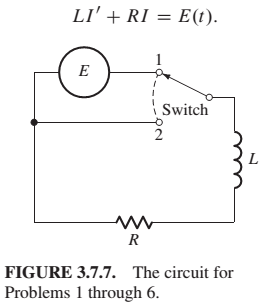
Problems 1 through 6 deal with the RL circuit of Fig. 3.7.7, a series circuit containing an inductor with an inductance of L henries, a resistor with a resistance of R ohms, and a source of electromotive force (emf), but no capacitor In this case Eq. (2) reduces to the linear first-order equation FIGURE 3.7.7. The circuit for Problems 1 through 6.

In the circuit of Fig. 3.7.7, with the switch in position 1, suppose that
Want to see the full answer?
Check out a sample textbook solution
Chapter 3 Solutions
EP DIFF.EQUAT.+BOUND.VALUE,...UPD.-ACC.
Additional Engineering Textbook Solutions
Starting Out with C++ from Control Structures to Objects (9th Edition)
Database Concepts (8th Edition)
Starting Out with Java: From Control Structures through Objects (7th Edition) (What's New in Computer Science)
Starting Out with Java: From Control Structures through Data Structures (4th Edition) (What's New in Computer Science)
Computer Science: An Overview (13th Edition) (What's New in Computer Science)
Java: An Introduction to Problem Solving and Programming (8th Edition)
- PLEASE SOLVE STEP BY STEP WITHOUT ARTIFICIAL INTELLIGENCE OR CHATGPT I don't understand why you use chatgpt, if I wanted to I would do it myself, I need to learn from you, not from being a d amn robot. SOLVE STEP BY STEP I WANT THE DIAGRAM PERFECTLY IN SIMULINKarrow_forwardI need to develop and run a program that prompts the user to enter a positive integer n, and then calculate the value of n factorial n! = multiplication of all integers between 1 and n, and print the value n! on the screen. This is for C*.arrow_forwardI need to develop and run a C* program to sum up integers from 1 to 100, and print out the sum value on the screen. Can someone help please?arrow_forward
- Given the schema below for the widgetshop, provide a schema diagram. Schema name Attributes Widget-schema Customer-schema (stocknum, manufacturer, description, weight, price, inventory) (custnum, name, address) Purchased-schema (custnum, stocknum, pdate) Requestedby-schema (stocknum, custnum) Newitem-schema (stocknum, manufacturer, description) Employee-schema (ssn, name, address, salary) You can remove the Newitem-schema (red).arrow_forwardTrue or False: Given the sets F and G with F being an element of G, is it always ture that P(F) is an element of P(G)? (P(F) and P(G) mean power sets). Why?arrow_forwardCan you please simplify (the domain is not empty) ∃xF (x) → ¬∃x(F (x) ∨ ¬G(x)). Foarrow_forward
- HistogramUse par(mfrow=c(2,2)) and output 4 plots with different argument settings.arrow_forward(use R language)Scatter plot(a). Run the R code example, and look at the help file for plot() function. Try different values for arguments:type, pch, lty, lwd, col(b). Use par(mfrow=c(3,2)) and output 6 plots with different argument settings.arrow_forward1. Draw flow charts for each of the following;a) A system that reads three numbers and prints the value of the largest number.b) A system reads an employee name (NAME), overtime hours worked (OVERTIME), hours absent(ABSENT) and determines the bonus payment (PAYMENT).arrow_forward
- Scenario You work for a small company that exports artisan chocolate. Although you measure your products in kilograms, you often get orders in both pounds and ounces. You have decided that rather than have to look up conversions all the time, you could use Python code to take inputs to make conversions between the different units of measurement. You will write three blocks of code. The first will convert kilograms to pounds and ounces. The second will convert pounds to kilograms and ounces. The third will convert ounces to kilograms and pounds. The conversions are as follows: 1 kilogram = 35.274 ounces 1 kilogram = 2.20462 pounds 1 pound = 0.453592 kilograms 1 pound = 16 ounces 1 ounce = 0.0283 kilograms 1 ounce = 0.0625 pounds For the purposes of this activity the template for a function has been provided. You have not yet covered functions in the course, but they are a way of reusing code. Like a Python script, a function can have zero or more parameters. In the code window you…arrow_forwardmake a screen capture showing the StegExpose resultsarrow_forwardWhich of the following is not one of the recommended criteria for strategic objectives? Multiple Choice a) realistic b) appropriate c) sustainable d) measurablearrow_forward
 C++ for Engineers and ScientistsComputer ScienceISBN:9781133187844Author:Bronson, Gary J.Publisher:Course Technology Ptr
C++ for Engineers and ScientistsComputer ScienceISBN:9781133187844Author:Bronson, Gary J.Publisher:Course Technology Ptr Operations Research : Applications and AlgorithmsComputer ScienceISBN:9780534380588Author:Wayne L. WinstonPublisher:Brooks Cole
Operations Research : Applications and AlgorithmsComputer ScienceISBN:9780534380588Author:Wayne L. WinstonPublisher:Brooks Cole Systems ArchitectureComputer ScienceISBN:9781305080195Author:Stephen D. BurdPublisher:Cengage Learning
Systems ArchitectureComputer ScienceISBN:9781305080195Author:Stephen D. BurdPublisher:Cengage Learning Principles of Information Systems (MindTap Course...Computer ScienceISBN:9781285867168Author:Ralph Stair, George ReynoldsPublisher:Cengage Learning
Principles of Information Systems (MindTap Course...Computer ScienceISBN:9781285867168Author:Ralph Stair, George ReynoldsPublisher:Cengage Learning C++ Programming: From Problem Analysis to Program...Computer ScienceISBN:9781337102087Author:D. S. MalikPublisher:Cengage Learning
C++ Programming: From Problem Analysis to Program...Computer ScienceISBN:9781337102087Author:D. S. MalikPublisher:Cengage Learning A Guide to SQLComputer ScienceISBN:9781111527273Author:Philip J. PrattPublisher:Course Technology Ptr
A Guide to SQLComputer ScienceISBN:9781111527273Author:Philip J. PrattPublisher:Course Technology Ptr





